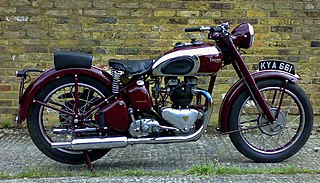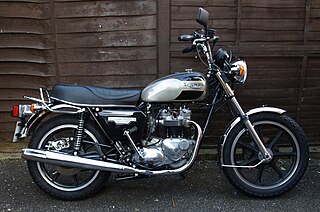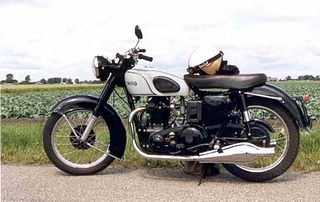 | |
| Manufacturer | Triumph |
|---|---|
| Production | 1949-1958 |
| Class | Standard |
| Engine | 498 cc (30.4 cu in) OHV four stroke parallel twin |
The TR5 Trophy was a standard motorcycle made by Triumph Engineering at the Meriden factory between 1949 and 1958. [1]
 | |
| Manufacturer | Triumph |
|---|---|
| Production | 1949-1958 |
| Class | Standard |
| Engine | 498 cc (30.4 cu in) OHV four stroke parallel twin |
The TR5 Trophy was a standard motorcycle made by Triumph Engineering at the Meriden factory between 1949 and 1958. [1]
Based on the Speed Twin, the TR5 was a trials machine designed for off-road use with a high level two into one exhaust and good handling on public roads. [2] The name 'Trophy' came from the three 'specials' that Triumph built for the Italian International Six Day Trial in 1948, which went on to win three gold medals and the manufacturers team trophy. [3] Racing in American Motorcyclist Association (AMA) Class C until 1969, the American export models included components from the Tiger 100 to create a motorcycle for desert competition. [4]
The original TR5 Trophy models of 1949 used the aluminum cylinder barrels and heads from a generator motor Triumph had supplied for the War Department in WW2. This was Triumph's first aluminum cylinder head/barrel, and factory employees speculated during the War that the alloy heads, with their superior cooling properties, could easily be adapted for a motorcycle. The TR5 Trophy models from 1949 to 1950 used modified versions of these cylinder heads, nicknamed the 'square barrel'. [3] From 1951 the 498 cc (30.4 cu in) engine was updated with new alloy barrels and heads with finer-pitch finning and a rounded profile, which was shared with the Tiger 100 model. The TR5 was replaced with a new range of unit construction twins in 1959. [3]

The Trophy name was extended to the TR6 Trophy and resurrected for the Trophy 500 (T100C) in 1971, which in turn was replaced by the Trophy Trail (TR5T) in 1973. This model enjoyed competition success gaining the British team individual gold medals and 2nd place overall in the 1973 ISDT competition held in the critical USA market. The new Triumph Motorcycles company also used the Trophy name for the Trophy 900 and Trophy 1200 models.
Inspired by Marlon Brando's 6T Triumph Thunderbird in The Wild One , James Dean bought a Triumph TR5 Trophy. Phil Stern's series of iconic photographs of Dean show him on this bike. It was sold after the actor's death, and then was retrieved, restored and displayed at the James Dean Gallery in Fairmount, Indiana. [5] [6] [7]
The Fonz, a character played by Henry Winkler in the popular and long-running American sit-com Happy Days , rode a mildly customized 1949 Trophy TR5 starting in Season 2. The motorcycle was provided by stuntman and Triumph dealer Bud Ekins, who removed the front fender, painted the fuel tank silver and changed the handlebars. The bike used in the sitcom was put up for auction in October 2011. [8] [9]
Triumph Engineering Co Ltd was a British motorcycle manufacturing company, based originally in Coventry and then in Meriden. A new company, Triumph Motorcycles Ltd, based in Hinckley, gained the name rights after the end of the company in the 1980s and is now one of the world's major motorcycle manufacturers.

The Triumph Triples are a family of modern DOHC inline three-cylinder motorcycle engines made from 1990 onwards by the Triumph Motorcycle Company at their Hinckley, Leicestershire factory. The inspiration for the later triples was the pushrod Triumph Trident, produced from 1968 to 1974 at the Triumph factory at Meriden Works.

The Triumph Bonneville is a standard motorcycle featuring a parallel-twin four-stroke engine and manufactured in three generations over three separate production runs.

Unit construction is the design of larger motorcycles where the engine and gearbox components share a single casing. This sometimes includes the design of automobile engines and was often loosely applied to motorcycles with rather different internal layouts such as the flat twin BMW models.

The BSA Gold Star is a motorcycle made by BSA from 1938 to 1963. They were 350 cc and 500 cc single-cylinder four-stroke production motorcycles known for being among the fastest bikes of the 1950s. Being hand-built and with many optional performance modifications available, each motorcycle came from the factory with documented dynamometer test results, allowing the new owner to see the horsepower (bhp) produced.

Edward Turner was an English motorcycle designer. He was born in Camberwell in the London Borough of Southwark, on the day King Edward VII was proclaimed King. In 1915, Turner had his first ride on a motorcycle, a Light Tourist New Imperial.

The Matchless G80 is a single cylinder 500 cc British motorcycle built by Associated Motorcycles (AMC) between 1946 and 1966. During the 1950s and 1960s, the main export product for AMC was the AJS/Matchless range – the road bikes were very similar, often with only the badges distinguishing one marque from the other; the equivalent AJS being the Model 18.
Greeves Motorcycles was a British motorcycle manufacturer founded by Bert Greeves which produced a range of road machines, and later competition mounts for observed trials, scrambles and road racing. The original company produced motorcycles from 1952, funded by a contract with the Ministry of Pensions for their Invacar, a three-wheeler for disabled drivers.

The Speed Twin 5T is a standard motorcycle that was made by Triumph at their Coventry, and later Meriden factories. Edward Turner, Triumph's Chief Designer and managing director, launched the Triumph Speed Twin at the 1937 National Motorcycle Show. It was a 500 cc OHV vertical twin in a lightweight frame and the first truly successful British parallel twin, setting the standard for many twins to follow. After World War II the Speed Twin was responsible for the survival of Triumph, and several major British marques offered a 500 cc twin designed on similar lines to the Speed Twin.

The Tiger 100 (T100) was a standard motorcycle first made by the British motorcycle company Triumph in 1939. Production ceased when the Triumph factory was destroyed by German bombing in 1940 during World War 2, but recommenced in 1946. Several variants were manufactured until 1973.

Triumph Motorcycles Ltd is the largest UK-owned motorcycle manufacturer, established in 1983 by John Bloor after the original company Triumph Engineering went into receivership. The new company, initially called Bonneville Coventry Ltd, continued Triumph's lineage of motorcycle production since 1902. They have major manufacturing facilities in Thailand.

The BSA A7 was a 500cc motorcycle model range made by Birmingham Small Arms Company (BSA) at its factory in Armoury Road, Small Heath, Birmingham. The range was launched in 1946 using a 495 cc (30.2 cu in) long stroke engine. An improved 497 cc (30.3 cu in) version based on the BSA A10 engine was launched in 1950. The various A7 models continued in production with minor modifications until 1961/2 when they were superseded by the unit-construction A50 model.

The TR6 Trophy is a motorcycle that was made by Triumph, in Meriden, from 1956 to 1973, when it was replaced by the five-speed 750-cc Triumph Tiger TR7V. During this time, it was a successful model, particularly in the US. The competition variant, popularly known as the "desert sled", won numerous competitions throughout the late 1950s and 1960s. Steve McQueen's fondness for the model is well known, as is his participation in the 1964 ISDT on a TR6 Trophy.

The Triumph Bonneville T140 is a standard motorcycle with a 750 cc (46 cu in) capacity engine that was designed and built by Triumph Engineering at Meriden near Coventry.

The BSA C15 was a 250 cc single-cylinder ohv motorcycle manufactured by the British company BSA from September 1958 until 1967, and was BSA's first four-stroke unit-construction bike. For most of that period, after the introduction of 'Learner Laws' in 1961, a 250 cc was the largest capacity solo machine that a learner could ride unaccompanied when displaying L-plates in the United Kingdom. A road-going Sports derivative was added in 1961, and off-road versions, for Trials and Scrambles, were also available in the range.
The BSA B50 was a single-cylinder 499 cc (30.5 cu in) ohv motorcycle, produced by BSA at their factory in Small Heath, Birmingham. The last of the big capacity unit-construction singles from the Birmingham Small Arms company, it had an alloy engine with a bore of 84 mm (3.3 in) and a stroke of 90 mm (3.5 in). As well as the road version, special models were produced for off-road competition use.

The BSA B25 was a series of 250 cc (15 cu in) unit construction single-cylinder OHV four-stroke motorcycles made by the Birmingham Small Arms Company. Developed from the BSA C15, the machines were produced between 1967 and 1971. The B25 was the fastest British production 250.

The Norton Model 7 Dominator was a 500 cc vertical twin motorcycle manufactured by the Norton Motorcycle Company from 1949 to 1955. It was the first of Norton's Dominator range of motorcycles. The engine was designed by Bert Hopwood and was a departure from Norton's previous practice of producing single-cylinder machines. The Model 7 was used in Japan as a police motorcycle.

The Norton Model 99 Dominator was a 600 cc vertical twin motorcycle manufactured by the British Norton Motorcycle Company at their Bracebridge St, Birmingham factory from 1956 to 1962. The 99 was based on the 500 cc Model 88 Dominator with an enlarged engine. The model was superseded by the 650SS.
The Ducati Diana Mark 3, also known as the Ducati Diana SuperSport and commonly referred to as the Ducati Mark 3, is a 249 cc (15.2 cu in) single cylinder bevel drive SOHC motorcycle produced by the Italian manufacturer Ducati from 1962 to 1966. It was a higher performance version of the Ducati Diana and sold to the American market only. In 1963, Cycle World described it as "the fastest, and nearly the smoothest, standard motorcycle in the 250cc class". It was replaced in 1967 by the Ducati 250 Mark 3.